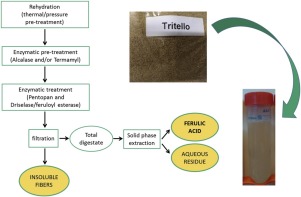当前位置:
X-MOL 学术
›
New Biotechnol.
›
论文详情
Our official English website, www.x-mol.net, welcomes your
feedback! (Note: you will need to create a separate account there.)
Advances in combined enzymatic extraction of ferulic acid from wheat bran
New Biotechnology ( IF 4.5 ) Pub Date : 2020-05-01 , DOI: 10.1016/j.nbt.2019.10.010 Maura Ferri 1 , Anton Happel 2 , Giulio Zanaroli 3 , Marco Bertolini 4 , Stefano Chiesa 4 , Mauro Commisso 5 , Flavia Guzzo 6 , Annalisa Tassoni 7
New Biotechnology ( IF 4.5 ) Pub Date : 2020-05-01 , DOI: 10.1016/j.nbt.2019.10.010 Maura Ferri 1 , Anton Happel 2 , Giulio Zanaroli 3 , Marco Bertolini 4 , Stefano Chiesa 4 , Mauro Commisso 5 , Flavia Guzzo 6 , Annalisa Tassoni 7
Affiliation

|
Wheat bran could be utilised as feedstock for innovative and sustainable biorefinery processes. Here, an enzymatic hydrolysis process for ferulic acid (FA) extraction was optimised step by step for total wheat bran (Tritello) and then also applied to the outer bran layer (Bran 1). Proteins, reducing sugars, total phenols and FA were quantified. The highest FA yields (0.82-1.05 g/kg bran) were obtained either by rehydrating the bran by autoclaving (Tritello) or by steam explosion (Bran 1) using a bran/water ratio of 1:20, followed by enzymatic pre-treatment with Alcalase and Termamyl, to remove protein and sugars, and a final enzymatic hydrolysis with Pentopan and feruloyl esterase to solubilise phenol. FA was recovered from the final digestate via solid phase extraction. A 40-fold scale-up was also performed and the release of compounds along all the process steps and at increasing incubation times was monitored. Results showed that FA was initially present at a minimum level while it was specifically released during the enzymatic treatment. In the final optimized process, the FA extraction yield was higher than that obtained with NaOH control hydrolysis while, in comparison with other FA enzymatic extraction methods, fewer process steps were required and no buffers, strong acid/alkali nor toxic compounds were used. Furthermore, the proposed process may be easily scaled-up, confirming the feasibility of wheat bran valorisation by biorefinery processes to obtain valuable compounds having several areas of potential industrial exploitation.
中文翻译:

联合酶法提取麦麸阿魏酸的研究进展
麦麸可用作创新和可持续生物精炼工艺的原料。在这里,阿魏酸 (FA) 提取的酶促水解过程逐步优化为全麦麸 (Tritello),然后也应用于外麸层 (麸 1)。对蛋白质、还原糖、总酚和 FA 进行定量。最高的 FA 产量 (0.82-1.05 g/kg 麸皮) 是通过使用麸皮/水比为 1:20 的高压灭菌 (Tritello) 或蒸汽爆炸 (麸皮 1) 对麸皮进行再水化获得的,然后进行酶促预处理用 Alcalase 和 Termamyl 去除蛋白质和糖,最后用 Pentopan 和阿魏酸酯酶进行酶水解以溶解苯酚。通过固相萃取从最终消化物中回收 FA。还进行了 40 倍的放大,并监测了所有工艺步骤中化合物的释放以及孵育时间增加的情况。结果表明 FA 最初以最低水平存在,而在酶促处理过程中被特异性释放。在最终优化过程中,FA 提取率高于 NaOH 控制水解获得的提取率,而与其他 FA 酶促提取方法相比,需要的工艺步骤更少,并且不使用缓冲剂、强酸/强碱或有毒化合物。此外,所提出的工艺可以很容易地扩大规模,证实了通过生物精炼工艺使麦麸增值的可行性,以获得具有多个潜在工业开发领域的有价值的化合物。结果表明 FA 最初以最低水平存在,而在酶促处理过程中被特异性释放。在最终优化过程中,FA 提取率高于 NaOH 控制水解获得的提取率,而与其他 FA 酶促提取方法相比,需要的工艺步骤更少,并且不使用缓冲剂、强酸/强碱或有毒化合物。此外,所提出的工艺可以很容易地扩大规模,证实了通过生物精炼工艺使麦麸增值的可行性,以获得具有多个潜在工业开发领域的有价值的化合物。结果表明 FA 最初以最低水平存在,而在酶促处理过程中被特异性释放。在最终优化过程中,FA 提取率高于 NaOH 控制水解获得的提取率,而与其他 FA 酶促提取方法相比,需要的工艺步骤更少,并且不使用缓冲剂、强酸/强碱或有毒化合物。此外,所提出的工艺可以很容易地扩大规模,证实了通过生物精炼工艺使麦麸增值的可行性,以获得具有多个潜在工业开发领域的有价值的化合物。FA 提取率高于使用 NaOH 控制水解获得的提取率,而与其他 FA 酶促提取方法相比,需要的工艺步骤更少,并且不使用缓冲液、强酸/碱或有毒化合物。此外,所提出的工艺可以很容易地扩大规模,证实了通过生物精炼工艺使麦麸增值的可行性,以获得具有多个潜在工业开发领域的有价值的化合物。FA 提取率高于使用 NaOH 控制水解获得的提取率,而与其他 FA 酶促提取方法相比,需要的工艺步骤更少,并且不使用缓冲液、强酸/碱或有毒化合物。此外,所提出的工艺可以很容易地扩大规模,证实了通过生物精炼工艺使麦麸增值的可行性,以获得具有多个潜在工业开发领域的有价值的化合物。
更新日期:2020-05-01
中文翻译:

联合酶法提取麦麸阿魏酸的研究进展
麦麸可用作创新和可持续生物精炼工艺的原料。在这里,阿魏酸 (FA) 提取的酶促水解过程逐步优化为全麦麸 (Tritello),然后也应用于外麸层 (麸 1)。对蛋白质、还原糖、总酚和 FA 进行定量。最高的 FA 产量 (0.82-1.05 g/kg 麸皮) 是通过使用麸皮/水比为 1:20 的高压灭菌 (Tritello) 或蒸汽爆炸 (麸皮 1) 对麸皮进行再水化获得的,然后进行酶促预处理用 Alcalase 和 Termamyl 去除蛋白质和糖,最后用 Pentopan 和阿魏酸酯酶进行酶水解以溶解苯酚。通过固相萃取从最终消化物中回收 FA。还进行了 40 倍的放大,并监测了所有工艺步骤中化合物的释放以及孵育时间增加的情况。结果表明 FA 最初以最低水平存在,而在酶促处理过程中被特异性释放。在最终优化过程中,FA 提取率高于 NaOH 控制水解获得的提取率,而与其他 FA 酶促提取方法相比,需要的工艺步骤更少,并且不使用缓冲剂、强酸/强碱或有毒化合物。此外,所提出的工艺可以很容易地扩大规模,证实了通过生物精炼工艺使麦麸增值的可行性,以获得具有多个潜在工业开发领域的有价值的化合物。结果表明 FA 最初以最低水平存在,而在酶促处理过程中被特异性释放。在最终优化过程中,FA 提取率高于 NaOH 控制水解获得的提取率,而与其他 FA 酶促提取方法相比,需要的工艺步骤更少,并且不使用缓冲剂、强酸/强碱或有毒化合物。此外,所提出的工艺可以很容易地扩大规模,证实了通过生物精炼工艺使麦麸增值的可行性,以获得具有多个潜在工业开发领域的有价值的化合物。结果表明 FA 最初以最低水平存在,而在酶促处理过程中被特异性释放。在最终优化过程中,FA 提取率高于 NaOH 控制水解获得的提取率,而与其他 FA 酶促提取方法相比,需要的工艺步骤更少,并且不使用缓冲剂、强酸/强碱或有毒化合物。此外,所提出的工艺可以很容易地扩大规模,证实了通过生物精炼工艺使麦麸增值的可行性,以获得具有多个潜在工业开发领域的有价值的化合物。FA 提取率高于使用 NaOH 控制水解获得的提取率,而与其他 FA 酶促提取方法相比,需要的工艺步骤更少,并且不使用缓冲液、强酸/碱或有毒化合物。此外,所提出的工艺可以很容易地扩大规模,证实了通过生物精炼工艺使麦麸增值的可行性,以获得具有多个潜在工业开发领域的有价值的化合物。FA 提取率高于使用 NaOH 控制水解获得的提取率,而与其他 FA 酶促提取方法相比,需要的工艺步骤更少,并且不使用缓冲液、强酸/碱或有毒化合物。此外,所提出的工艺可以很容易地扩大规模,证实了通过生物精炼工艺使麦麸增值的可行性,以获得具有多个潜在工业开发领域的有价值的化合物。











































 京公网安备 11010802027423号
京公网安备 11010802027423号